- Empty cart.
- Continue Shopping
The Monarch Corliss Steam Engine
It all started out innocently enough, three galoots getting together for a day of tooling in near Austin Texas. Bruce Willman, Dean Hohman and I met up at an antique mall in Elgin, TX. As I drove into Elgin, I noticed a troubling sign: “Welcome to Elgin, TX–Home of Antiques and Famous Sausage”. Not sure about the significance of the famous sausage, I was hoping that there would be some cool tools there. Arriving late, I went in and found Bruce and Dean already checking the store out. Stripping the place of a 3/16″ inch mortise chisel, we sounded the all clear signal and headed to the next town, Smithville, where it was reported that there were some antique stores. On the way into town we spotted what appeared to be a very large steam engine. Making a mental note of it, we proceeded past it, to check out the antique stores in Smithville. Before we started out, we had lunch at the local diner–which was inside a converted gas station. After making our rounds in town, we headed back out the way we came and stopped to check out the steam engine.
As we got out of the car, we were immediately impressed with the size of the thing. After looking around it for a bit, we decided to see if anyone there could tell us anything about it. The steam engine was located on the property of Clyde Clardy, the owner of BAS-CO, an auto parts repair place. We found Clyde under a shade tree working with one of his employees. I stopped and asked if he new anything about the steam engine. Only expecting a short couple of minutes of his time, we were delighted to spend almost an hour with Clyde as he told us about the steam engine. Before we get into that, however, take a few minutes to check out the following links to learn about how modern steam engines work:
By clicking here, you can go through the various stages of how a steam engine works.
By clicking here, you can see the whole process automated,running like an actual steam engine in motion.
Before we get into the engine located at Smithville, a very short treatment about George Corliss is in order. George Corliss was not the inventor of the modern steam engine. James Watt is largely identified as the father of the modern steam engine. The watt, a unit of work, is named after James Watt. George Corliss is important as he invented a shuttle type valve which allowed the steam engine to be very efficient. From what I have read, before the Corliss valve, steam engines were limited in size and horsepower output due to the fact that the steam condensed inside the piston, drawing heat from the engine, slowing it down and robbing it of power. Corliss invented a valve which allowed the steam to quickly pressurize each side of the piston, moving it back and forth before the steam could condense.
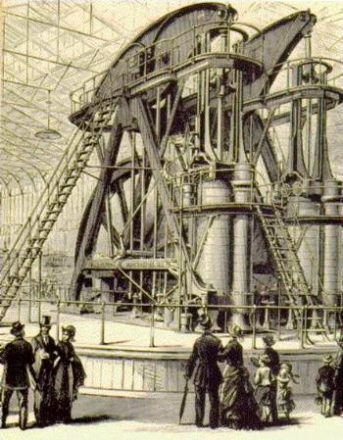
The crowning achievement of George Corliss was the steam engine that he built for the 1876 Centennial Exposition. The engine seen at the left was 70 feet tall and weighed over 650 tons. It was the largest steam engine ever built. It had a 1400 horsepower output. The main gearwheel alone weighed 56 tons and was 30 feet in diameter. The engine powered the entire machinery hall at the exposition and symbolized the growing industrial might of the United States. On the opening day of the expo, President U.S. Grant started the engine which ran continuously for the next 6 months. Four years later, George Pullman bought the engine and shipped it in 35 boxcars to Chicago to use at his sleeping car works. There the Corliss labored for the next 30 years. After that, Pullman sold the behemoth for scrap for $8 per ton–a paltry sum of $5200!
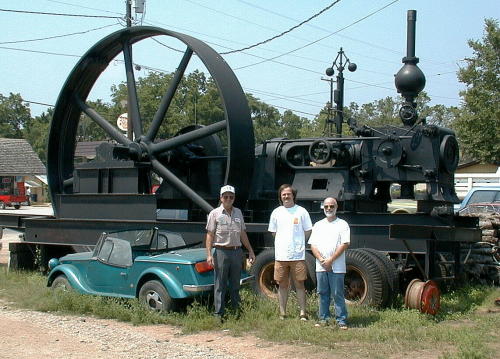
Such was the fate of most of the steam engines when their useful lives were over. Clyde told us that the first time he saw this particular steam engine was when it was first installed in the local cotton mill. He was a small boy, and the whole town turned out to watch it first start to operate. He told us that it literally made the hair stand up on the back of his neck. His father later told Clyde that he vowed to own a steam engine like that one day. Fast forward to the future. A few years back the same cotton mill was being demolished. Most of the cotton industry had left that part of Texas, and there was no need for the mill or the steam engine that lay inside. Clyde showed up the first day that demolition was to begin. As the wrecking ball started to swing, Clyde asked the demolition manager what was to happen to the Corliss. The Manager told him it would be cut up for scrap. Clyde started to talk to the man about what he thought it was worth. After a complex series on negotiations involving the price of cast iron and how much both men thought the steam engine weighed, a deal was Struck. Clyde would pay the site manager $1000 cash, and he would have just three days to get the steam engine out of the building or all bets were off. Since Clyde had all sorts of rigging equipment from his auto salvage business, moving the steam engine was a challenge but not impossible. In the picture above is the Monarch Corliss Steam Engine, and from left to right, Clyde Clardy, the owner and fellow galoots Dean Hohman and Bruce Willman.
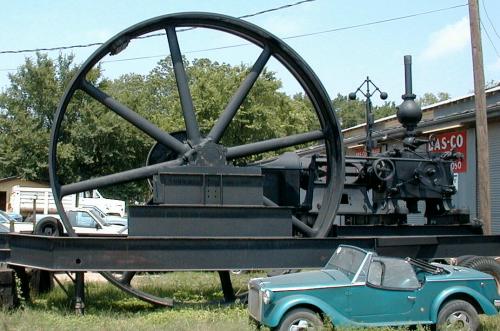
Clyde’s Corliss, while not as big as the one at the exposition, it still one mean piece of machinery. Clyde has mounted the engine on a mobile platform to move it around. He last had it operating 6 years ago. Unfortunately, since it is on a mobile platform, he needs to carry $500,000 of liability insurance to operate it. Clyde’s ultimate goal it to mount it on the ground on a piece of property that he owns along highway 71. He said that way he could fire it up whenever he wanted and everyone could enjoy it. The main gearwheel on this engine weighs 6 tons and is 16 feet in diameter. The engine as it is seen at the left weighs over 33 tons, and does not include the weight of the boiler and counter pulley system used to increase the rpm output of the engine. When operating at top speed, the engine is rated at 100 horsepower. The main gearwheel has a maximum speed of 30 RPM. A two foot wide leather belt stretched from the main gear wheel to the counter pulley system which drove the main line shaft of the cotton mill.
To get an idea of the scale of this engine, the main axle of the gearwheel can be seen at the right. It is approximately 10 inches in diameter. The axle rides in cast iron pillow blocks which are Babbitt lined. The engine is complete with all the glass oiling cups. It is interesting to note how the main bearing assembly is put together. The top cap is bolted to the main pillow block. When the Babbitt starts to wear, the cap is removed. Inside are many sheets of thin shim stock. Some of the shims are removed until the cap seats tightly on the axle again. By doing this, the Babbitt bearing material lasts a very long time and down time of the engine is reduced. The gearwheel is cast in two sections which are bolted together by flanges on the inside of the wheel.
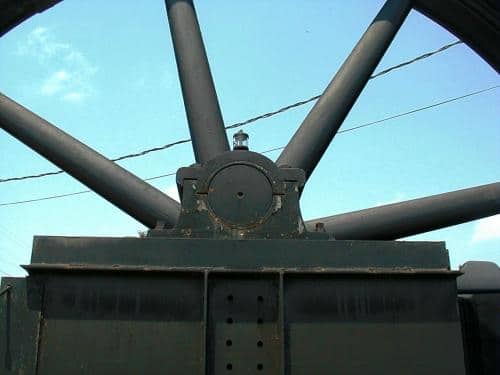
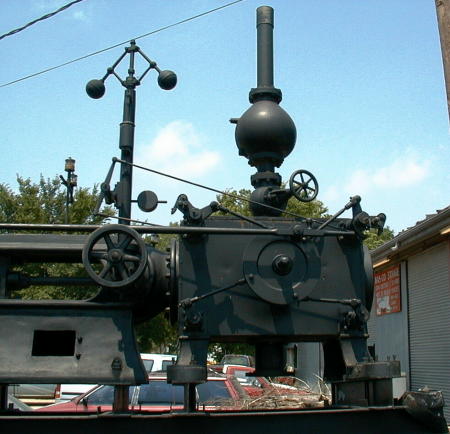
At the left is the part of the steam engine which houses the piston. The high pressure steam which is under about 125 psi of pressure is introduced via the four inch stack at the top of the engine. Some of the steam condenses into water when it hits the cooler metal of the steam engine. This is collected in the bulbous condenser which is in line with the steam inlet and is run out of the steam line. There is a diaphragm inside to prevent the high pressure steam from escaping in this process. From there the steam enters the Corliss Valve, the heart of the process. The round wheel with the two rocker arms are the exterior controls of the valve. They operate in concert with the governor which is the weather vane type apparatus to the left of the main stack. As the output of the steam engine decreases, the balls of the spinning governor drop. When they drop they allow the Corliss valve to introduce more steam which speeds the whole engine up.
At the right can be seen the main transmission of the engine. It is here that the in and out motion of the engine’s piston is converted to a circular motion. At the left of the photo can be seen a casting with an open area. The rod in the center of the casting is connected on the left side to the center of the piston inside the engine. On the right side it is connected to the two shoes which ride on the top and bottom of the open part of the casting. If you look closely, you will see two oil ways which carry oil to the upper bearing surface and to the lower bearing surface. The oil ways which keeps the lower bearing surface lubricated has to move with the assembly. To watch all the moving parts work in unison on this engine must be fantastic. The other end of the shoe assembly is attached the main drive rod. The drive rod is attached to the main drive wheel which is bolted to the gear wheel. Since the rod is bolted to the edge of the wheel, it causes the drive wheel to rotate, which in turn rotates the main wheel.
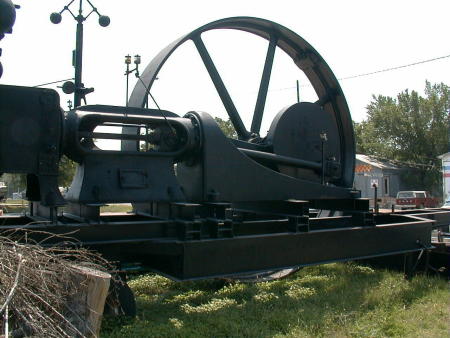
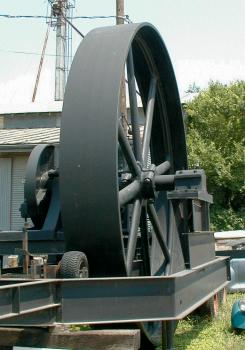
The linkage and the interaction of the drive wheel and the gear wheel can be seen in the photo at the right. It is interesting to note that the drive wheel is solid cast iron. Clyde told us that it takes a good 15 minutes for the steam engine to stop turning due to the kinetic energy stored in the two wheels once the steam is shut off. In the photo at the left, another view of the main gear wheel can be seen. One of the other reasons that Clyde doesn’t operate the engine much anymore is that the height of the entire mobile assembly is over 16 feet which is taller than most of the underpasses that populate the area.
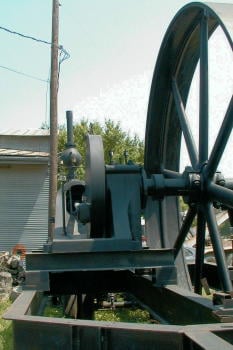
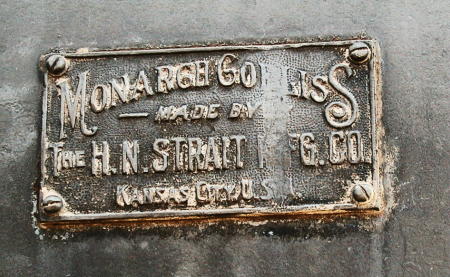
In the photo at the left can be seen the only manufacturing information existing on the engine. Clyde told us that this particular engine was made in 1856. Since this engine was not made by the Corliss Steam Engine Company, one can only assume that it was made under license from Corliss. After about an hour of talking and questions, we left Clyde and the Corliss. He told us in closing that “Your hormones are in the right place” for stopping to check out the Corliss. As he went on, we could tell that he enjoyed telling us about the engine as much as we enjoyed hearing about it, and told us as much as we walked toward the car. I’m pleased to report that the galoots spirit is alive an well in Smithville, TX.
